The MSI GT75 Titan Laptop Review: Hex-Core DTR
by Brett Howse on September 13, 2018 9:00 AM EST- Posted in
- Laptops
- Gaming
- MSI
- Pascal
- Coffee Lake
- Coffee Lake-H
System Performance
Intel’s Coffee Lake is a nice upgrade, offering up to six cores in the 45-Watt H series, compared to four in Kaby Lake. MSI offers either the Core i7-8750H, Core i7-8850H, or the Core i9-8950HK, with the latter installed in the review unit. The Core i9-8950HK offers six cores, 12 threads, and a 2.9-4.8 GHz operating window at stock speeds. There’s 12 MB of cache, and of course the 45-Watt TDP.
The review unit also comes with 2 x 16 GB DDR4-2667, and there’s two more SODIMM slots if you need more memory than that. The base models come with just a single 16 GB stick, so while you do lose out on the dual-channel memory, it’s nice that if you do want to upgrade to 32 GB of memory, you don’t need to buy two sticks of memory.
To test system performance, the GT75 Titan was run through our standard laptop tests. Comparisons are against similar systems and a few others, but if you want to compare it to any laptop we’ve tested, you can use our online Bench.
PCMark
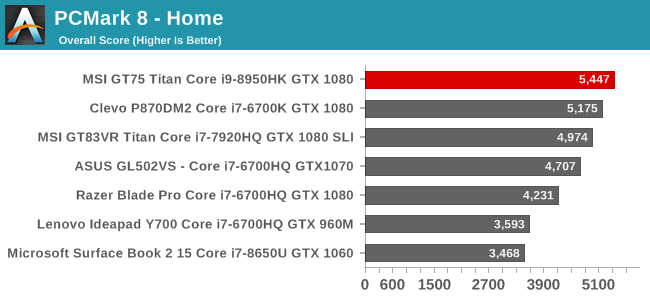
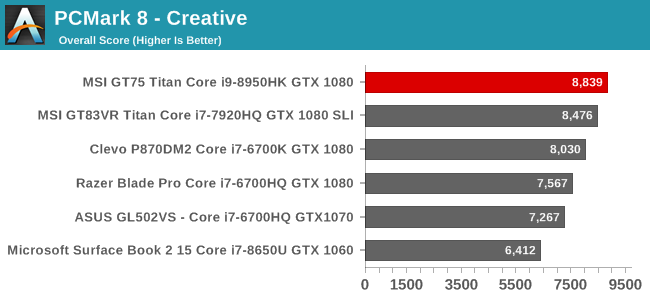
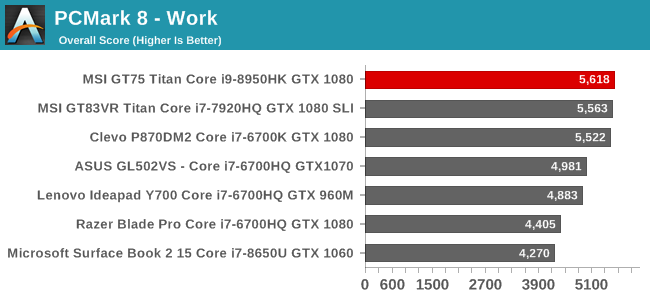




PCMark tests all aspects of a system, including the CPU, GPU, and storage. The extra cores in the GT75 Titan help propel it to the tops of these tests, even compared to the Clevo P870DM2 with it’s desktop class Core i7-6700K CPU.
Cinebench
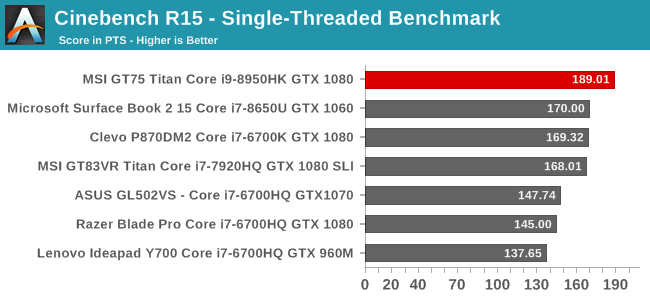
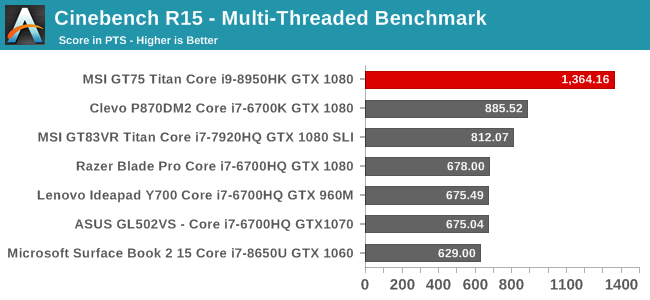
Cinebench is a pure CPU test, and with both single-threaded and multi-threaded tests, we can take a look at both the single-core performance as well as when all six cores and twelve threads are in use. With a maximum turbo frequency of 4.8 GHz, the Core i9-8950HK pulls out a nice lead on the single-threaded result, and the extra cores absolutely demolish the quad-cores in previous laptops.
x264
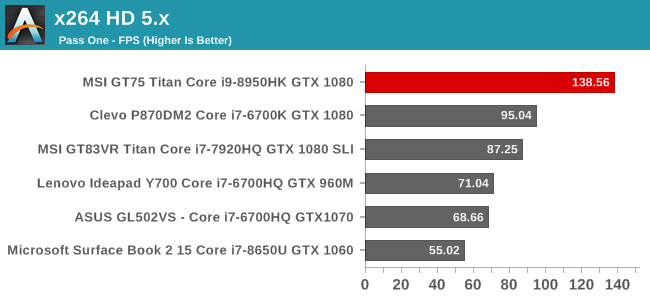
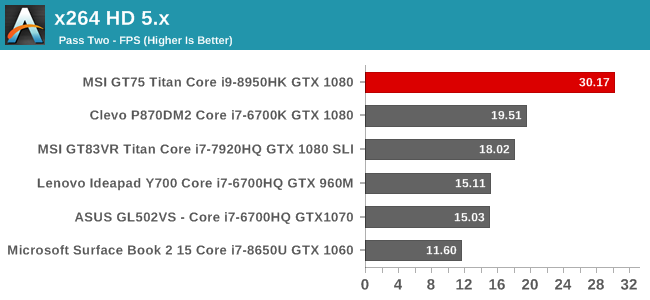
Another CPU test, x264 does a video conversion over two passes. The workload is quite long, and on Ultrabooks it can bump into the thermal limits of a device, but on these desktop replacement systems that’s not an issue. The MSI GT75 Titan once again flexes its extra two cores here and wipes the floor against even the fastest quad-core models we’ve tested.
Web Tests
All of our web tests are done with the latest version of Microsoft Edge, and unlike our other tests, web performance is often dictated by the browser. Over time, browsers tend to get faster at certain tasks, so even the same device may show different results later in its life.
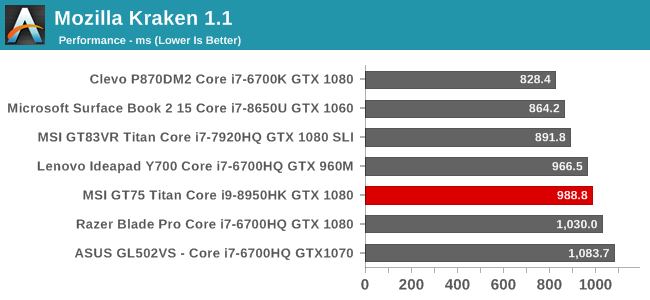
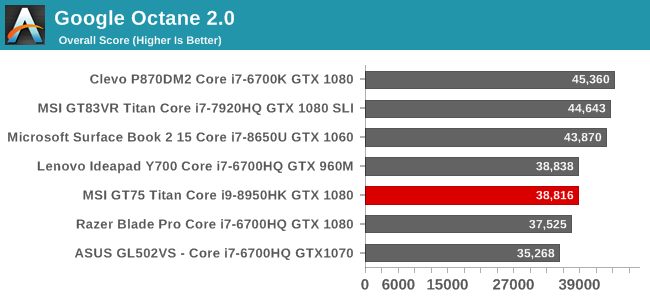
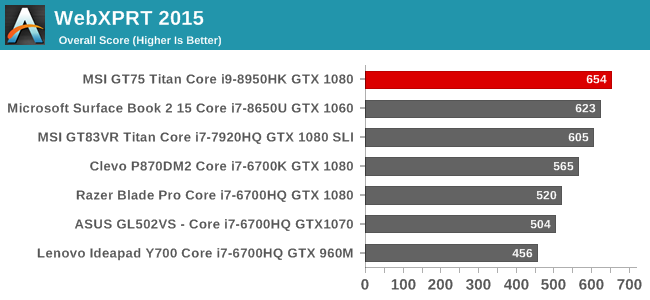
Interestingly, the Kraken 1.1 and Octane results are a bit lower for this laptop compared to some of the previous generation devices we’ve tested. However the WebXPRT results do show an improvement. At the end of the day, laptops with H series CPUs tend to not struggle with web workloads regardless.
Storage Performance
You can get the GT75 Titan with just a 1 TB 7200 rpm drive, or MSI offers models with 256 and 512 GB SATA SSDs, and models with either a single 512 GB NVMe, or two 512 GB NVMe in RAID. There’s three total M.2 slots, so after purchase, there’s room to upgrade as well. It’s nice that all models come with the 1 TB spinning drive though, since the install size for games these days can be well over 100 GB per game.
As enthusiasts, it can be a bit disheartening that SSDs have become commodities for laptop manufacturers, but that is certainly the case. The review unit we received from MSI ships with the Samsung PM981 512 GB SSD. This 64-layer TLC drive is one of the best performing TLC drives around, and if you want to read more about it please check out our review.
The Samsung PM981 is perhaps not quite as fast as their Pro series with MLC NAND, but for most people, the speed difference is mostly academic. The PM981 can saturate a PCI 3.0 x4 link on reads, and still does awfully well on writes.
SSDs in laptops is a bit of a lottery, but this GT75 Titan has a great SSD. They offer this in RAID 0 as well for 1 TB total, which is going to perform marginally better, but likely not enough for anyone to really notice except on synthetic tests.


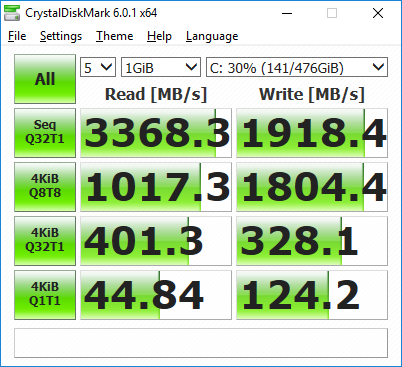








48 Comments
View All Comments
RSAUser - Saturday, September 15, 2018 - link
Not really, at 3ft distance and 17", you can definitely notice the difference in sharpness between 1080p and 4k, heck, I can notice it between 1440p and 4k.The TN panel should have at least been 1440p.
milkod2001 - Tuesday, September 18, 2018 - link
Yeah, well how is windows scaling working on 17''laptop with 4k screen?ralstonater - Monday, October 1, 2018 - link
I have the 4k-071 model and I can verify that the scaling works and looks just fine on my laptop :)milkod2001 - Tuesday, September 18, 2018 - link
At 3ft distance if you can notice any difference in sharpness between 1080 and 4k on 17''screen you must be using 1'' thick glasses with some laser enhancements and binoculars attached. Bet you got there night vision too. Haha.darkich - Sunday, September 16, 2018 - link
You're either crazy either have serious eyesight impairment.1080p TN on a 17" laptop with this price and this GPU is an absolute insult to common sense.
If you are fine with paying that much money for staring into something that looks worse than a $300 tablet screen, well..no further comment.
milkod2001 - Tuesday, September 18, 2018 - link
The absolute insult for me would be paying nearly 3 grand for laptop. No matter how great it is, it is aimed at stupid people. 17'' laptop will sit on table 100% of times. Why not spend 3grand on desktop with 2 times better performance and at least 27''screen? Kinda silly, don't you agree?1080p on 17" is perfectly fine. I don't expect 4k on 17'' screen scaling great using Windows.
zoxo - Thursday, September 13, 2018 - link
120Hz screenDanNeely - Thursday, September 13, 2018 - link
The extra size should make this significantly quieter than a thin and light gaming laptop.This will comfortably do 1080p 120hz, and has a decent margin to keep being able to do so for a few years before frame rates fall too low vs something with a lower end GPU that thermal throttles harder because of size.
That said, I really would like to see 15.6/17.3" 1440p laptop screens since that appears to be the sweet spot for current generation GPUs.
bennyg - Friday, September 14, 2018 - link
You'd think that, but all the high end DTRs have pretty similar jet turbines under load reaching above 55dBa, because they're all set to turbo themselves as high as they'll go, which is almost always limited by cooling. Idle and part load noise is a tradeoff between temps and noise up to the user via fan control schemesRSAUser - Saturday, September 15, 2018 - link
You can set them all to be adaptive/set to screen resolution.Nvidia control panel > Manage 3D settings > Power management mode to adaptive.
It's one of the first changes I make on any Nvidia or AMD card, what's the point in pushing twice the amount of frames needed, I'd rather use less power and have the fan quieter.